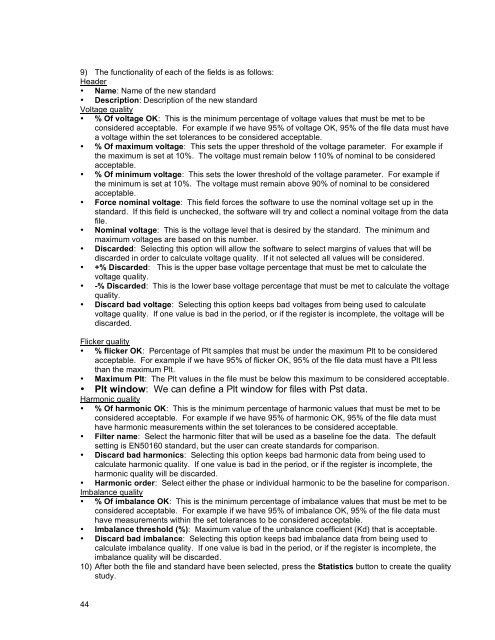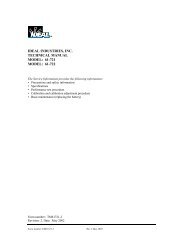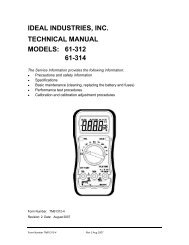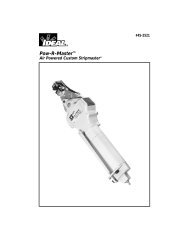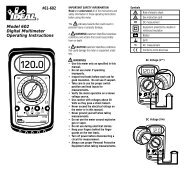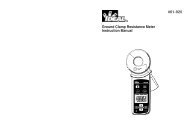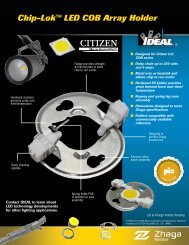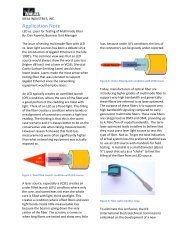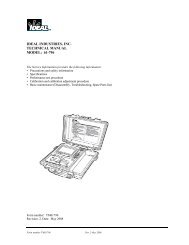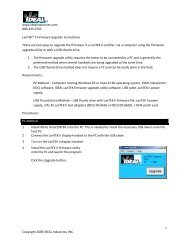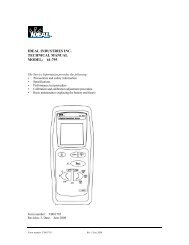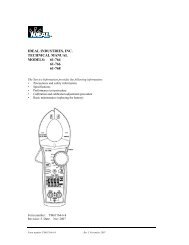800 Series Power Analyzer PowerVision⢠Instruction Manual
800 Series Power Analyzer PowerVision⢠Instruction Manual
800 Series Power Analyzer PowerVision⢠Instruction Manual
You also want an ePaper? Increase the reach of your titles
YUMPU automatically turns print PDFs into web optimized ePapers that Google loves.
9) The functionality of each of the fields is as follows:<br />
Header<br />
• Name: Name of the new standard<br />
• Description: Description of the new standard<br />
Voltage quality<br />
• % Of voltage OK: This is the minimum percentage of voltage values that must be met to be<br />
considered acceptable. For example if we have 95% of voltage OK, 95% of the file data must have<br />
a voltage within the set tolerances to be considered acceptable.<br />
• % Of maximum voltage: This sets the upper threshold of the voltage parameter. For example if<br />
the maximum is set at 10%. The voltage must remain below 110% of nominal to be considered<br />
acceptable.<br />
• % Of minimum voltage: This sets the lower threshold of the voltage parameter. For example if<br />
the minimum is set at 10%. The voltage must remain above 90% of nominal to be considered<br />
acceptable.<br />
• Force nominal voltage: This field forces the software to use the nominal voltage set up in the<br />
standard. If this field is unchecked, the software will try and collect a nominal voltage from the data<br />
file.<br />
• Nominal voltage: This is the voltage level that is desired by the standard. The minimum and<br />
maximum voltages are based on this number.<br />
• Discarded: Selecting this option will allow the software to select margins of values that will be<br />
discarded in order to calculate voltage quality. If it not selected all values will be considered.<br />
• +% Discarded: This is the upper base voltage percentage that must be met to calculate the<br />
voltage quality.<br />
• -% Discarded: This is the lower base voltage percentage that must be met to calculate the voltage<br />
quality.<br />
• Discard bad voltage: Selecting this option keeps bad voltages from being used to calculate<br />
voltage quality. If one value is bad in the period, or if the register is incomplete, the voltage will be<br />
discarded.<br />
Flicker quality<br />
• % flicker OK: Percentage of Plt samples that must be under the maximum Plt to be considered<br />
acceptable. For example if we have 95% of flicker OK, 95% of the file data must have a Plt less<br />
than the maximum Plt.<br />
• Maximum Plt: The Plt values in the file must be below this maximum to be considered acceptable.<br />
• Plt window: We can define a Plt window for files with Pst data.<br />
Harmonic quality<br />
• % Of harmonic OK: This is the minimum percentage of harmonic values that must be met to be<br />
considered acceptable. For example if we have 95% of harmonic OK, 95% of the file data must<br />
have harmonic measurements within the set tolerances to be considered acceptable.<br />
• Filter name: Select the harmonic filter that will be used as a baseline foe the data. The default<br />
setting is EN50160 standard, but the user can create standards for comparison.<br />
• Discard bad harmonics: Selecting this option keeps bad harmonic data from being used to<br />
calculate harmonic quality. If one value is bad in the period, or if the register is incomplete, the<br />
harmonic quality will be discarded.<br />
• Harmonic order: Select either the phase or individual harmonic to be the baseline for comparison.<br />
Imbalance quality<br />
• % Of imbalance OK: This is the minimum percentage of imbalance values that must be met to be<br />
considered acceptable. For example if we have 95% of imbalance OK, 95% of the file data must<br />
have measurements within the set tolerances to be considered acceptable.<br />
• Imbalance threshold (%): Maximum value of the unbalance coefficient (Kd) that is acceptable.<br />
• Discard bad imbalance: Selecting this option keeps bad imbalance data from being used to<br />
calculate imbalance quality. If one value is bad in the period, or if the register is incomplete, the<br />
imbalance quality will be discarded.<br />
10) After both the file and standard have been selected, press the Statistics button to create the quality<br />
study.<br />
44


